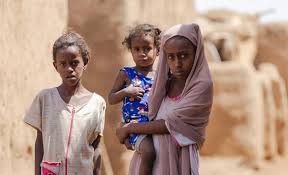Sudan Faces Famine Risk Amid Ongoing Conflict and Economic Instability
overview
Sudan, a country plagued by persistent conflict and economic challenges, is now facing the dire risk of famine. This alarming situation has been exacerbated by ongoing political instability, armed conflict, and natural disasters, which have collectively pushed numerous regions into severe food insecurity. Humanitarian organizations are raising the alarm, emphasizing the urgent need for international assistance to prevent a catastrophic famine that could affect millions of people.
Root Causes of the Crisis
The root causes of Sudan’s potential famine are multifaceted and interlinked:
Armed Conflict:
- Internal Strife: Sudan has experienced prolonged periods of internal conflict, particularly in regions such as Darfur, South Kordofan, and the Blue Nile. These conflicts have displaced millions of people, disrupted agricultural activities, and destroyed infrastructure vital for food production and distribution (Voice of America).
- Power Struggles: The power struggles between different factions, including the government forces and various rebel groups, have created an environment of instability and violence. This has hindered humanitarian access and exacerbated food shortages (Voice of America) (IOL | News that Connects South Africans).
Economic Instability:
- Inflation and Currency Devaluation: Sudan’s economy has been in turmoil, marked by hyperinflation and a devaluing currency. The cost of living has skyrocketed, making basic food items unaffordable for many households (IOL | News that Connects South Africans).
- Sanctions and Isolation: Economic sanctions and international isolation have further strained Sudan's economic situation, limiting its ability to import necessary food supplies and agricultural inputs (IOL | News that Connects South Africans).
Natural Disasters:
- Droughts and Floods: Sudan is highly vulnerable to climate change, experiencing extreme weather conditions such as droughts and floods. These natural disasters have devastated crops, reduced agricultural yields, and displaced communities (Voice of America).
- Desertification: The encroachment of the desert into arable land has reduced the amount of land available for farming, further contributing to food insecurity (Voice of America).
Current Situation
As of mid-2024, reports indicate that 14 regions within Sudan are at severe risk of famine. The Integrated Food Security Phase Classification (IPC) has placed these regions in IPC Phase 4 (Emergency) and IPC Phase 5 (Catastrophe/Famine). This classification signifies that large segments of the population are experiencing acute malnutrition, with elevated mortality rates expected if immediate interventions are not implemented (IOL | News that Connects South Africans).
Humanitarian Efforts and Challenges
Humanitarian organizations, including the United Nations World Food Programme (WFP) and various non-governmental organizations (NGOs), are actively working to mitigate the crisis. These efforts include:
Food Assistance:
- Emergency Food Distribution: The WFP and other agencies are distributing emergency food supplies to the most affected regions. These efforts are crucial for providing immediate relief to starving populations (IOL | News that Connects South Africans).
- Nutrition Programs: Special nutrition programs targeting children, pregnant women, and lactating mothers are being implemented to combat acute malnutrition and prevent long-term health consequences (IOL | News that Connects South Africans).
Agricultural Support:
- Seed and Tool Distribution: To revive agricultural activities, humanitarian organizations are distributing seeds and farming tools to displaced and affected farmers. This support aims to help communities rebuild their livelihoods and ensure food production in the upcoming planting seasons (Voice of America).
- Training and Resources: Training programs are being provided to farmers on sustainable agricultural practices and climate-resilient farming techniques to improve food security in the long term (Voice of America).
Health and Sanitation:
- Medical Assistance: Health interventions, including the provision of medical supplies and support for local healthcare facilities, are being intensified to address the health impacts of malnutrition and food scarcity (Voice of America).
- Water and Sanitation Projects: Projects to improve access to clean water and sanitation are crucial in preventing the spread of diseases, which are common in famine situations (Voice of America).
International Response
The international community has recognized the severity of the situation in Sudan and is mobilizing resources to provide aid. However, challenges remain:
Funding Gaps:
- Insufficient Funding: Despite the efforts, there are significant funding gaps. Humanitarian agencies have reported that the current funding levels are inadequate to meet the growing needs of the affected populations (IOL | News that Connects South Africans).
- Delayed Contributions: Pledges of aid often face delays in disbursement, which hampers timely and effective response efforts (IOL | News that Connects South Africans).
Access and Security:
- Insecurity and Violence: Ongoing conflict and insecurity in many regions of Sudan make it difficult for humanitarian workers to access and assist those in need safely. Aid convoys are often targeted, and areas of intense conflict remain inaccessible (Voice of America).
- Bureaucratic Hurdles: Government-imposed restrictions and bureaucratic obstacles further complicate the delivery of aid, delaying critical assistance to vulnerable populations (IOL | News that Connects South Africans).
The Human Cost
The human cost of the impending famine in Sudan cannot be overstated. Millions of people, including children, are at risk of severe malnutrition and starvation. The psychological impact on families and communities is profound, as they struggle to cope with the loss of livelihoods and the uncertainty of their future.
Conclusion
Sudan’s looming famine is a result of a complex interplay of conflict, economic instability, and environmental challenges. Immediate and sustained international assistance is crucial to prevent a full-scale humanitarian catastrophe. While efforts are underway, the scale of the crisis requires a coordinated and comprehensive response from the global community. Ensuring that aid reaches those in need, addressing the root causes of the conflict, and supporting sustainable agricultural practices are essential steps towards alleviating the crisis and building a resilient future for Sudan.4




.jpeg)
.jpeg)






0 Comments